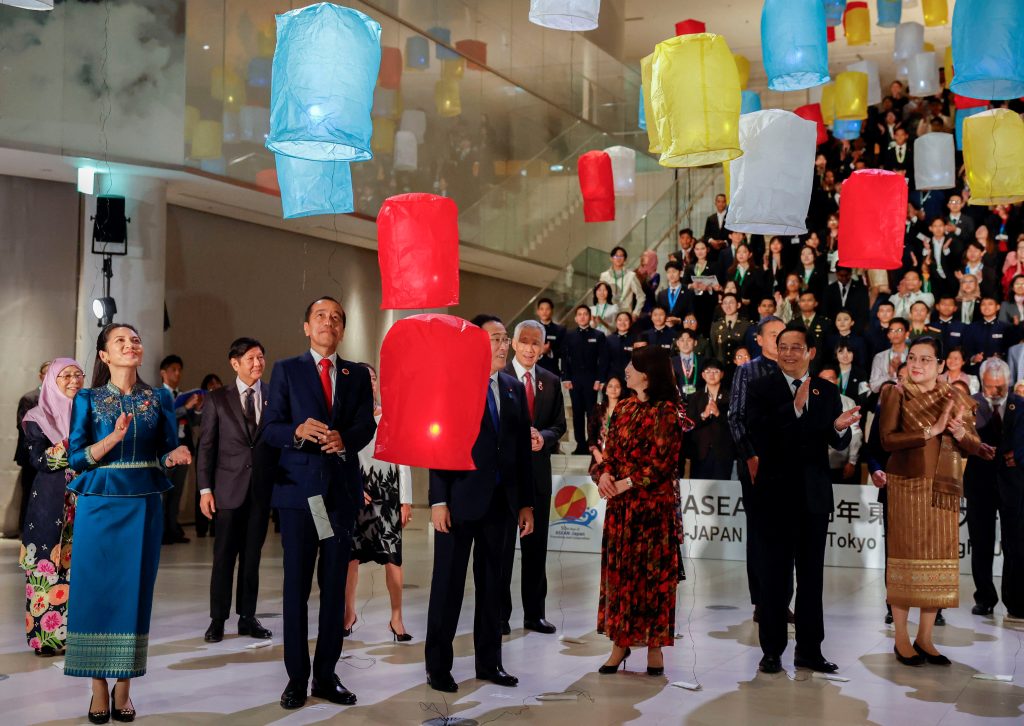In December 2023, ASEAN gathered for the 50th iteration of the ASEAN-Japan Commemorative Summit. The bloc has always had a very special relationship with Japan.
Southeast Asia was very different when this relationship began in the 1970s. Issues ranging from political instability in the Mekong to low agricultural yields in Java kept policymakers awake at night. Yet one bright spot was the role played by Japan. The Fukuda Doctrine, enunciated in 1977, declared Japan’s resolve to never again become a military power and that it would seek a ‘heart-to-heart’ relationship with Southeast Asia.
In practical terms, Japanese foreign direct investment helped uplift productivity in the labour-intensive industries of Singapore, Malaysia, Thailand, Indonesia and the Philippines. This process gained further momentum in the aftermath of the 1985 Plaza Accord, as the yen significantly appreciated against major currencies.
Japan’s sustained economic boom also offered a large, lucrative market for Southeast Asian exporters. Official development assistance — based on the principles of self-help and sensitivity to host state context — was also extended to catalyse Southeast Asian growth.
Over time, Southeast Asia has developed rapidly. Japan facilitated this growth, transferring capital and technology to its neighbours. But by the 1990s, the slowing down of the Japanese economy, coupled with the strong performance of firms from other high-growth East Asian economies somewhat dampened this vision.
While Japan still maintains trade surplus in technology-intensive goods and services, its connections with Southeast Asia, once mainly driven by economic concerns, have evolved into a more interpersonal and multidimensional partnership. This shift is evident in the enduring popularity of Japanese educational programs, cultural events and entertainment across Southeast Asia.
These exchanges, representing the softer elements of the Fukuda Doctrine, have evolved beyond diplomatic formalities into meaningful and transformative interactions. The growing willingness of Japanese businesses to hire Southeast Asian talent to run their operations, not just graduates from Japanese universities, is another obvious case.
Despite recent challenges in great power relations, there are still opportunities for ASEAN and Japan to collaborate. It is easy to forget that Japan took the lead in keeping internationally significant initiatives like the Trans-Pacific Partnership alive — converting it into the Comprehensive and Progressive Agreement for Trans-Pacific Partnership after the United States withdrew from the original agreement.
Although only four ASEAN member states have ratified their participation in this economic partnership, the possibility remains open for others to join in the future. Related to this is ASEAN’s adept balancing of interests in implementing the Regional Comprehensive Economic Partnership, which brought together member states and their Plus Five partners, China, Japan, Korea, Australia and New Zealand.
During the late 1990s and early 2000s, cautious consultation and tacit diplomacy by Japanese economic elites helped lay the groundwork for what eventually became the ASEAN+3 Macroeconomic Research Office (AMRO). Though its inception came after virtually all the East Asian nations were bruised by the 1997 Asian Financial Crisis, AMRO arguably represents the closest substitute East Asia has to a ‘regional self-help institution’.
The initiative has since become a knowledge hub, contributing to the macroeconomic and financial resilience and stability of the region through surveillance, regional financing arrangements and technical assistance. More practically, AMRO offers a discreet second opinion to ASEAN+3 financial authorities, unlike the high-profile and vocal approach taken by the International Monetary Fund during the Asian Financial Crisis.
The Japanese approach to diplomacy and regional integration is markedly different to that of other major powers. It emphasises consensus-building and ‘leading from behind’. These practices, though time-consuming and not always publicised, are valued by Southeast Asian nations.
Japan’s goal is to engage in sincere dialogues with all parties, even those with differing ideologies. This is particularly important in the management of territorial disputes. To this end, both ASEAN and Japan must cooperate as promoters of the regional order rather than mere beneficiaries of it.
On the economic front, more rigorous support to Southeast Asian economies suffering from the middle-income trapwould be highly beneficial. Though each nation’s development path is unique, the middle-income trap commonly stems from the struggle to progressively master technological know-how and extract more value from producing and selling increasingly complex goods and services.
To this end, a better grasp of how Japan absorbed and improvised foreign technology in the post-World War Two era could offer valuable insights for economies caught in the trap. Still, there is a catch. The contemporary global economy’s increased trade and investment openness has rendered many policies used by earlier industrialised nations ineffective or illegal.
Manufacturing and trading a new generation of products, such as electric vehicles and cloud computing, also creates a challenge which even the most advanced nations cannot solve on their own. This is where closer cooperation and perhaps ‘co-creation’ with other developing nations — especially those within Southeast Asia — is worth looking at.
To foster avenues and strengthen dialogue, Japan and ASEAN must continue growing educational institutions and providing patient capital. This is the bare minimum that both actors must strive for as they work towards a more enriching and sustainable relationship in the next decades.
Guanie Lim is Assistant Professor at the National Graduate Institute for Policy Studies, Japan.
Nguyen Nhat Anh is a Masters Student at the National Graduate Institute for Policy Studies, Japan.


The Association of Southeast Asian Nations and Japan have undergone a transformative shift in their economic-centric relationships, expanding towards more multifaceted partnerships that encompass cultural and educational exchanges. They have also joined forces to address regional challenges and embrace technological advancements. To nurture sustained dialogue and collaboration, it is crucial for both parties to demonstrate patience and commitment in investing in education and mutual growth. This approach will contribute to the establishment of a more sustainable and mutually enriching relationship for the future.